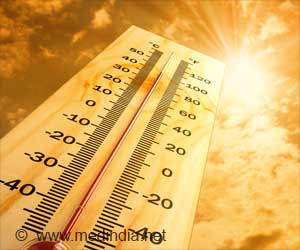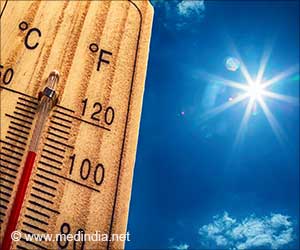High nighttime temperatures increase mortality rates by doubling heat-related health risks, especially without air conditioning.
- High nighttime temperatures can significantly increase mortality, particularly for vulnerable populations
- Prolonged exposure to both daytime and nighttime heat disrupts the body’s ability to recover, increasing the risk of heat-related illness
- Passive cooling solutions and climate resilience measures are essential to protect economically disadvantaged communities from extreme heat
Deepening and Expanding Heat Health Action in India
Go to source).
A "wet-bulb" temperature of 35°C is considered the upper limit of human survival, where sweat stops cooling you down! Stay cool—literally! #heatwave #health #medindia’
The Ahmedabad Study: Nighttime Heat and Mortality
A pivotal study by the IIPH, which informed the development of Ahmedabad’s heat response policy, examined daily mortality rates in Ahmedabad from 2001 to 2016. The findings were stark: when maximum daytime temperatures exceeded 45°C and nighttime temperatures remained above 30°C, mortality rates nearly doubled compared to nights when temperatures were between 28°C and 30°C. This significant increase highlights the crucial role nighttime temperatures play in determining public health outcomes during heatwaves.As Dr. Dileep Mavalankar, former director of IIPH Gandhinagar, explains, "The body needs the nighttime to recover from the heat of the day. When temperatures remain high at night, the body is unable to rest adequately, leading to exhaustion and overexertion." He compares this to forcing someone to run without rest, causing them to collapse eventually. The body, in such conditions, goes into overdrive, which can result in heat-related illnesses and death.
The importance of tracking all-cause mortality during heatwaves, using historical data to assess excess deaths attributed to heat, cannot be overstated. Dr. Mavalankar emphasizes that understanding the relationship between heatwaves and mortality is key to improving preparedness and response measures.
Record-Breaking Temperatures in Delhi and Beyond
Delhi, like many other parts of northwest and east India, has been experiencing a severe heatwave, with the India Meteorological Department (IMD) reporting record-breaking nighttime temperatures. In June, the minimum temperature in Delhi reached a scorching 35.2°C- eight notches above average and the highest minimum temperature recorded in June since 1969. This marked the city’s sixth consecutive "warm night," as defined by IMD: a night with a minimum temperature at least 4.5°C above normal.Across the region, other states, including Punjab, Haryana, West Uttar Pradesh, and Bihar, have also experienced similar hot nights during May and June, contributing to a rise in heat-related illnesses and deaths. Despite the ongoing heat crisis, the Indian government has yet to release official death data, leaving the true impact of these heatwaves largely unquantified.
Global Evidence on Nighttime Heat and Mortality
India is not alone in facing the deadly consequences of nighttime heat. A paper published in Lancet Planetary Health in August 2022 examined data from 28 cities across Japan, South Korea, and China, analyzing over 9.1 million deaths. The study revealed that the mortality risk during hot nights is 50% greater than on cooler nights, with the relative mortality risk rising significantly when nighttime temperatures remain high (2✔ ✔Trusted SourceThe effects of night-time warming on mortality burden under future climate change scenarios: a modelling study
Go to source). This underscores the global threat posed by increasing nighttime temperatures, particularly as climate change intensifies.
In areas with high humidity, the situation becomes even more dangerous. The combined effect of heat and humidity, often expressed through the heat index, can create conditions that are intolerable for human survival. The study noted that a wet-bulb temperature (TW) of 35°C is considered the upper limit of physiological tolerance for humans. Beyond this threshold, the body’s cooling mechanisms fail, leading to potentially fatal outcomes such as hyperthermia.
Impact of High Nighttime Temperatures on Vulnerable Populations
High nighttime temperatures are particularly dangerous for vulnerable populations, including the elderly, infants, and individuals living in poverty. Without access to air conditioning or other cooling methods, these individuals face a disproportionately higher risk of heat-related illness. As Dr. Sumit Ray, Critical Care Specialist and Medical Director at Holy Family Hospital, explains, "During hot days and nights, the body does not have time to cool down, and people frequently do not sleep, increasing the risk of heat stroke." The elderly and infants, with their limited ability to regulate body temperature, are at heightened risk.The combined effect of high temperatures and humidity creates a lethal environment in regions like West Bengal and Bihar, where the heat index regularly reaches dangerous levels. In these areas, Dr. Mavalankar suggests monitoring all-cause mortality rates on a daily basis to track the potential impact of heatwaves and identify high-risk populations.
Adaptive Solutions: A Call for Urgent Action to Create Sustainable Cooling Solutions
The ongoing heat crisis in India highlights the need for immediate and targeted adaptation solutions, particularly for economically disadvantaged communities. Abhiyant Tiwari, lead climate resilience and health consultant at NRDC India, stresses the importance of implementing passive cooling methods in homes lacking air conditioning. Programs like Telangana’s cool roof initiative offer a model for creating more sustainable, affordable cooling solutions that do not exacerbate climate change by increasing energy consumption.For those who must work outdoors, avoiding peak afternoon hours and ensuring access to safe, clean drinking water are essential preventive measures. Unfortunately, many workers have little choice but to endure these extreme conditions, leading to heat stress, dehydration, and even gastroenteritis, as noted by Dr. Ray.
In cases of heat-related emergencies, Dr. Ray advises using cooling methods such as placing cool packs in the armpits, groin, and forehead to reduce body temperature. However, individuals with severe symptoms, such as high fever or vomiting, should seek medical attention promptly.
Broader Implications of Climate Change
The increasing frequency of heatwaves and high nighttime temperatures in India is a direct result of climate change, which continues to disproportionately affect those least responsible for global warming. As Sunita Narain, director general of the Centre for Science and Environment, aptly points out, "The irony is that those who suffer the most from climate change- such as the millions exposed to blazing sun and unbearable heat- are not responsible for the rise in global temperatures."Climate change has become an urgent global challenge, and India’s heat crisis is a stark reminder of the need for global cooperation to reduce greenhouse gas emissions and mitigate the impacts of rising temperatures. Cooling solutions, such as passive methods and energy-efficient technologies, must be prioritized to protect vulnerable populations from the worst effects of extreme heat.
The growing threat posed by high nighttime temperatures in India demands immediate attention from policymakers, health professionals, and communities alike. The findings of the IIPH study in Ahmedabad, combined with global research on the dangers of nighttime heat, underscore the urgent need for heat adaptation strategies. By investing in sustainable cooling solutions and improving public health infrastructure, India can protect its most vulnerable citizens from the devastating effects of extreme heat while addressing the broader challenges of climate change.
References:
- Deepening and Expanding Heat Health Action in India - (https://iiphg.edu.in/key-projects/)
- The effects of night-time warming on mortality burden under future climate change scenarios: a modelling study - (https://www.thelancet.com/journals/lanplh/article/PIIS2542-5196(22)00139-5/fulltext)
Source-Medindia










